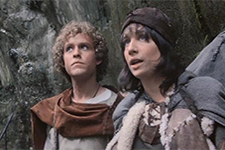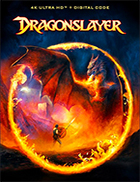Dragonslayer (4K UHD)
|  Matthew Robbins’s Dragonslayer, an ambitious, big-budget production co-financed by Paramount and Disney, was one of the first serious attempts in the 1980s to make a blockbuster fantasy film that might rival the success of science fiction hits like Star Wars (1977) and Close Encounters of the Third Kind (1977). This was despite the fact that, at the time, sword-and-sorcery movies had been woefully out of vogue (but, then again, so was science fiction pre-Star Wars). The 1980s saw a spate of fantasy cheapies glutting theaters and then video rental stores, so the genre became associated with low budgets, no-name stars, and hackneyed scripts. The quick death of Dragonslayer at the box office may be largely to blame for why virtually no one tried to mount a major fantasy production for some time, and it wasn’t until the thunderous success of The Lord of the Rings trilogy in the early 2000s that the genre rose in popularity again. Peter MacNicol, an established theatre actor who was most likely cast for his likeness to Mark Hamill, made his feature-film debut as Galen, a young and ambitious sorcerer’s apprentice who is tasked with ridding a mediaeval kingdom of a fearsome dragon after his mentor, the aging and cantankerous sorcerer Ulrich (Ralph Richardson), is killed. Galen is led to the kingdom of Urland by a small group of people led by a headstrong youth named Valerian (Caitlin Clarke). They are tired of the King’s (Peter Eyre) solution to the dragon problem, which is to sacrifice a female virgin to it twice a year. While on the surface Dragonslayer is an old-fashioned fantasy yarn, it functions also as an interesting political allegory about the nature of sacrifice and what is ultimately best for the populace. The King’s solution is a draconian one, indeed, and it is riddled with corruption, as wealthy families are able to buy their daughters out of the biyearly lotteries that decide who will become dragon fodder in the name of saving everyone else. Naturally, it is an open secret that the King’s only daughter, Elspeth (Chloe Salaman), is also exempt from the lotteries. Nevertheless, the King makes a good point when challenged by the idealistic and ultimately naïve Galen, that these sacrifices ultimately save lives because the dragon does not attack the kingdom so long as they go on. Thus, the question becomes one of sacrifice and whether it is acceptable for a few to suffer against their will so that so many others may live. Galen decides to bypass the philosophical conundrum altogether by simply vanquishing the beast, which he thinks he has done at one point, but in fact has only raised the dragon’s ire. When it attacks the kingdom, laying waste to entire villages, Galen feels responsible and takes it upon himself to enter the dragon’s lair and dispatch it with an enormous spear known as the “dragonslayer,” his only protection being a shield composed of the dragon’s own scales. This is by far the best sequence in the film, as Galen’s descent into the lair is structured as a descent into Dante’s inferno, complete with a flaming lake and horrific imagery of the dragon’s progeny feasting on the remains of young virgin (despite its brevity, the goriness of this scene strikes one as quite intense, particularly for a PG-rated movie bearing Disney’s imprimatur). The special effects used to portray the dragon were revolutionary at the time, although the blue-screen work and obvious matte lines can be somewhat distracting to a modern viewer raised on CGI. The major innovation was a process developed by Industrial Light & Magic known as Go-Motion, which was a variation on stop-motion animation that used computer-timed movements to smooth out the motion, effectively eliminating the jerkiness inherent to the process by introducing motion blur. Comparing the Go-Motion in Dragonslayer with Ray Harryhausen’s stop-motion work on Clash of the Titans, another fantasy movie released that same year, is a testament to the former’s superiority. The dragon in Dragonslayer, whether crawling through its cavernous lair on its wings or soaring through the sky, is a marvelous creation. However, Robbins knew that a good monster needs a good build-up, so like Steven Spielberg did in Jaws (1975), he keeps it largely off-screen for the first two-thirds of the film, only suggesting its presence with a brief shot of its claws or an extreme close-up of the back of its head as it rises out of the ground to claim a victim. Cinematographer Derek Vanlint, whose curiously short filmography also includes Ridley Scott’s Alien (1979), gives Dragonslayer a strong visual look. He includes plenty of postcard-beautiful shots of the medieval English moors and mountains, but he really excels when called upon to create a dark, moody environment. The night scenes in Dragonslayer are inky and dense, and the scenes in the dragon’s lair are appropriately claustrophobic with their strong contrasts of shadow and red firelight. If Dragonslayer has a letdown, it is the somewhat anemic script by director Robbins and Hal Barwood, which establishes a lot of interesting ideas, but falls short in character development. With the exception of Ralph Richardson’s gloriously haggard portrayal of Ulrich, all the characters simply fill slots, generating little emotional investment. Still, the movie works as a whole because it is so true to its calling; it evokes the tangible magic and myth of the fantasy genre, which is what the best of them do.
Copyright © 2023 James Kendrick Thoughts? E-mail James Kendrick All images copyright © Paramount Home Entertainment | |||||||||||||||||||||||||||||
Overall Rating: 

 (3)
(3)


